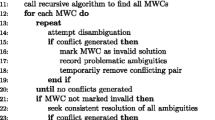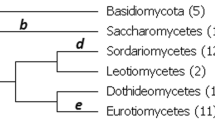Abstract
We have isolated clones of a processed pseudogene of mouse t complex polypeptide 1 (Tcp-1) and determined the nucleotide sequence of the pseudogene. The pseudogene was 1363 bp long and had no intron. The Tcp-1 pseudogene had 88.4% or 88.3% nucleotide identity to the mouse Tcp-1 cDNA of wild-type (Tcp-1)bor t haplotype (Tcp-1)a, and 87.5% identity to the rat Tcp-1 cDNA. On 12 nucleotide positions where the open reading frames (ORFs) of mouse Tcp-1 band Tcp-1 acDNAs have bp substitutions, the Tcp-1 pseudogene had 6 bp identical to Tcp-1 b, 5 bp identical to Tcp-1 aand 1 bp not identical to neither. On ten amino acid positions where TCP-1B and TCP-1A polypeptides have substitutions, deduced amino acids of the Tcp-1 pseudogene had four amino acids identical to TCP-1B, five amino acids identical to TCP-1A and one amino acid identical to neither. These results suggest that the ancestral mouse Tcp-1 gene would have had no significant difference between the resemblance to Tcp-1 band that to Tcp-1 abefore they were diverged and that amino acids of TCP-1B and TCP-1A would have been substituted in similar high rates.
Similar content being viewed by others
References
Ahmad, S. and Gupta, R.S.: Cloning of a Chinese hamster protein homologous to the mouse t-complex protein TCP-1: Structural similarity to the ubiquitous “chapelonin” family of heat-shock proteins. Biochem Biophys Acta 1087: 253–255, 1990.
Bullard, D.C. and Schimenti, J.C.: Molecular cloning and genetic mapping of the t complex responder candidate gene family. Genetics 124: 957–966, 1990.
Committee for Mouse Chromosome 17 {Artzt, K., Barlow, D., Dove, W.F., Fischer-Lindahl, K., Klein, J., Lyon, M.F., and Silver, L.M.}: Maps of mouse chromosome 17: First report. Mammalian Genome 1: 5–29, 1991
Creighton, T.E. and Darby, N.J.: Functional evolutionary divergence of proteolytic enzymes and their inhibitors. Trend Biochem Sci 14: 319–324, 1989.
Delarbre, C., Kashi, Y., Boursot, P., Beckmann, J.S., Kourilsky, P., Bonhomme, F., and Gachelin, G.: Phylogenetic distribution in the genus Mus of t-complex-specific DNA and protein markers: Inference on the origin of t-haplotypes. Mol Biol Evol 5: 120–133, 1988.
Dudley, K., Shanahan, F., Burtenshaw, M., Evans, E.P., Ruddy, S., and Lyon, M.F.: Isolation and characterization of a cDNA clone corresponding to the mouse t-complex gene Tcp-1x. Genet Res Camb 57: 147–152, 1991.
Frischauf, A.M.: The T/t complex of the mouse. Trends Genet 1: 100–103, 1985.
Hammer, M.F., Schimenti, J., and Silver, L.M.: Evolution of mouse chromosome 17 and the origin of inversions associated with t haplotypes. Proc Natl Acad Sci USA 86: 3261–3265, 1989.
Ichinose, Y., Morita, T., Zhang, F., Srimahasongcram, S., Tondella, M.L.C., Matsumoto, M., Nozaki, M., and Matsushiro, A.: Nucleotide sequence and structure of mouse cytokeratin endoB gene. Gene 70: 85–95, 1988.
Jukes, T.H. and Cantor, C.H.: Evolution of protein molecules. In H.N. Munro (ed.) Mammalian Protein Metabolism III, pp. 21–132, Academic Press, New York, 1969.
Kirchhoff, C. and Willison, K.R.: Nucleotide and amino-acid sequence of human testis-derived TCP1. Nucl Acids Res 18: 4247, 1990.
Klein, J., Sipos, P., and Figueroa, F.: Polymorphism of t-complex genes in European wild mice. Genet Res Camb 44: 39–46, 1984.
Kubota, H., Morita, T., Nagata, T., Takemoto, Y., Nozaki, M., Gachelin, G., and Matsushiro, A.: Nucleotide sequence of mouse Tcp-1 acDNA. Gene 105: 269–273, 1991.
Lyon, M.F.: Transmission ratio distortion in mouse t-haplotypes is due to multiple distorter genes acting on a responder locus. Cell 37: 621–628, 1984.
McDonald, J.H. and Kreitman, M.: Adaptive protein evolution at the Adh locus in Drosophila. Nature 351: 652–654, 1991.
Nei, M.: Molecular Evolutionary Genetics, Columbia University Press, New York, 1987.
Nizetic, D., Figueroa, F., and Klein, J.: Evolutionary relationships between the t and H-2 haplotypes in the house mouse. Immunogenetics 19: 311–320, 1984.
Ruvinsky, A., Polyakov, A., Agulnik, A., Herbert, T., Figueroa, F., and Klein, J.: Low diversity of t haplotypes in the eastern form of the house mouse, Mus musculus L. Genetics 127: 161–168, 1991.
Saitou, N. and Nei, M.: Neighbor-joining method: A new method for reconstructing phylogenetic trees. Mol Biol Evol 4: 406–425, 1987.
Sanger, F., Nicklen, S., and Coulson, A.R.: DNA sequencing with chain-terminating inhibitors. Proc Natl Acad Sci USA 74: 5463–5467, 1977.
Silver, L.M.: Mouse t haplotypes. Ann Rev Genet 19: 179–208, 1985.
Silver, L.M., artzt, K., and Bennett, D.: A major testicular cell protein specified by a mouse T/t complex gene. Cell 17: 275–284, 1979.
Silver, L.M., and Remis, D.: Five of the nine genetically defined regions of mouse t haplotypes are involved in transmission ratio distortion. Genet Res Camb 49: 51–56, 1987.
Silver, L.M., Kleen, K.C., Distel, R.J., and Hecht, N.B.: Synthesis of mouse t complex proteins during haploid stages of spermatogenesis. Develop Biol 119: 605–608, 1987.
Silver, L.M., Michael, H., Fox, H., Garrels, J., Bucan, M., Herrmann, B., Frischauf, A.-M., Lehrach, H., Winking, H., Figueroa, F., and Klein, J.: Molecular evidence for the rapid propagation of mouse t haplotypes from a single, recent ancestral chromosome. Mol Biol Evol 4: 1–10, 1987.
Sokal, R.R. and Sneath, P.H.A.: Principles of Numerical Taxonomy, W. H. Freeman and Company, New York, 1963.
Ursic, D. and Ganetzky, B.: A Drosophila melanogaster gene encodes a protein homologous to the mouse t complex polypeptide 1. Gene 68: 267–274, 1988.
Willison, K.R., Dudley, K., and Potter, J.: Molecular cloning and sequence analysis of a haploid expressed gene encoding t complex polypeptide 1. Cell 44: 727–738, 1986.
Willison, K., Kelley, A., Dudley, K., Goodfellow, P., Spurr, N., Groves, V., Gorman, P., Sheer, D., and Trowsdale, J: The human homologue of the mouse t-complex gene, TCP-1, is located on chromosome 6 but not near the HLA region. EMBO J 6: 1867–1974, 1987.
Willison, K., Lewis, V., Zukerman, K.S., Cordel, J., Dean, C., Miller, K., Lyon, M.F., and Mash, M.: The t complex polypeptide 1 (TCP-1) is associated with the cytoplasmic aspect of Golgi membranes. Cell 57: 621–632, 1989.
Author information
Authors and Affiliations
Additional information
The nucleotide sequence data reported in this paper have been submitted to GenBank and have been assigned the accession number D00851.
Rights and permissions
About this article
Cite this article
Kubota, H., Morita, T., Satta, Y. et al. Nucleotide sequence of a mouse Tcp-1 pseudogene: A nucleotide record for a t complex gene carried by an ancestor of the mouse. Mammalian Genome 2, 246–251 (1992). https://doi.org/10.1007/BF00355434
Received:
Accepted:
Issue Date:
DOI: https://doi.org/10.1007/BF00355434




